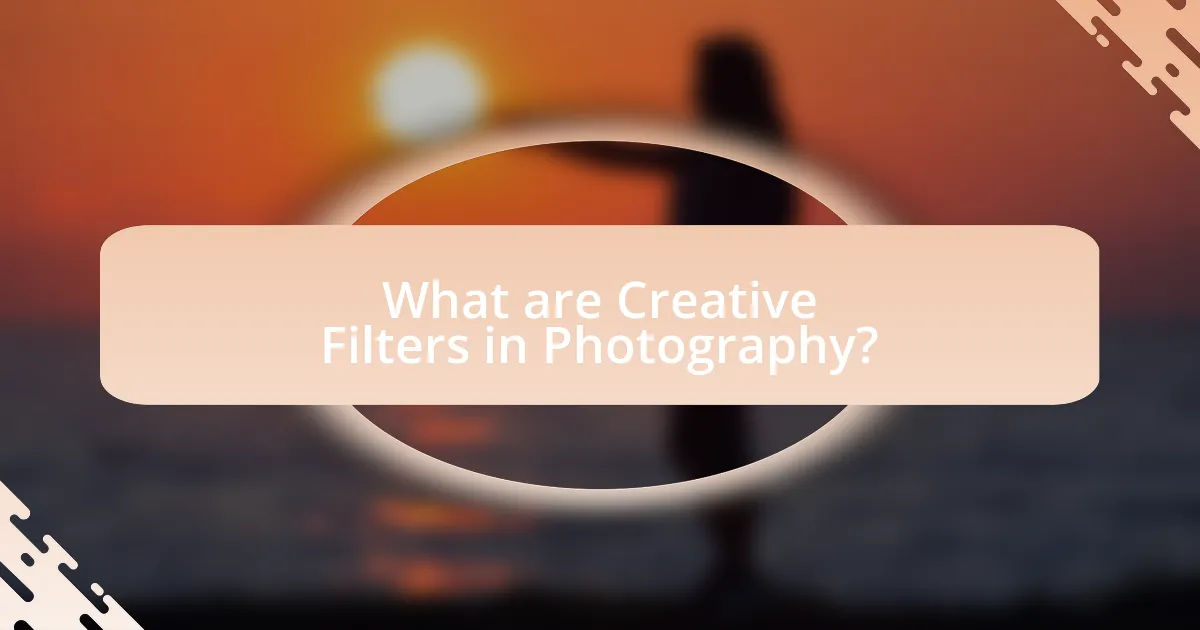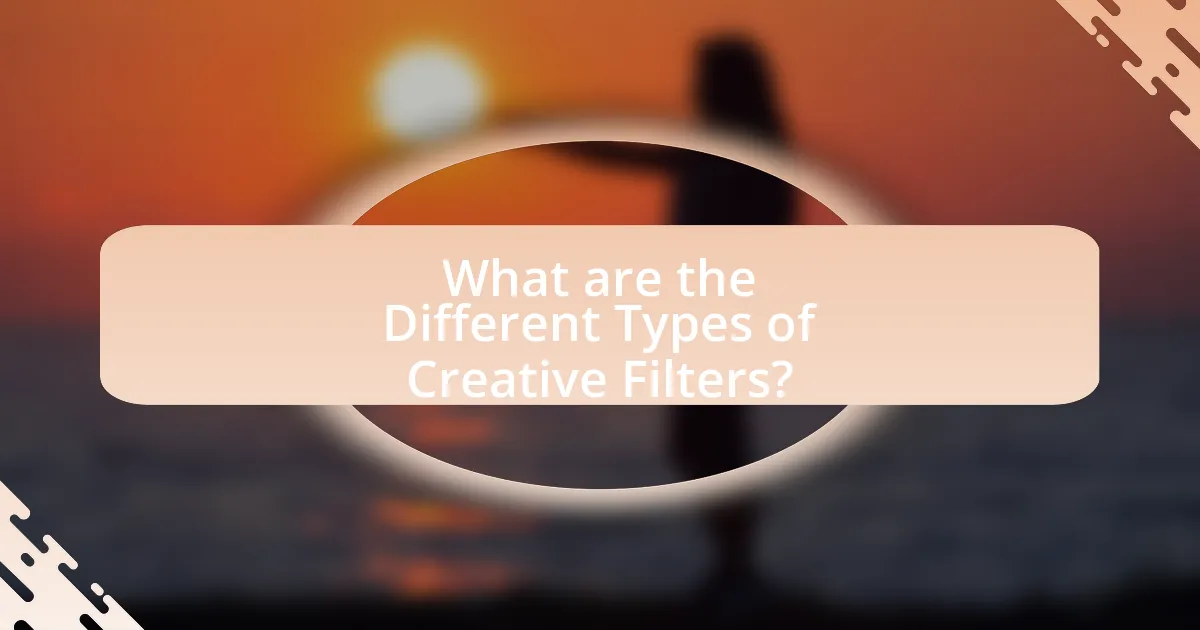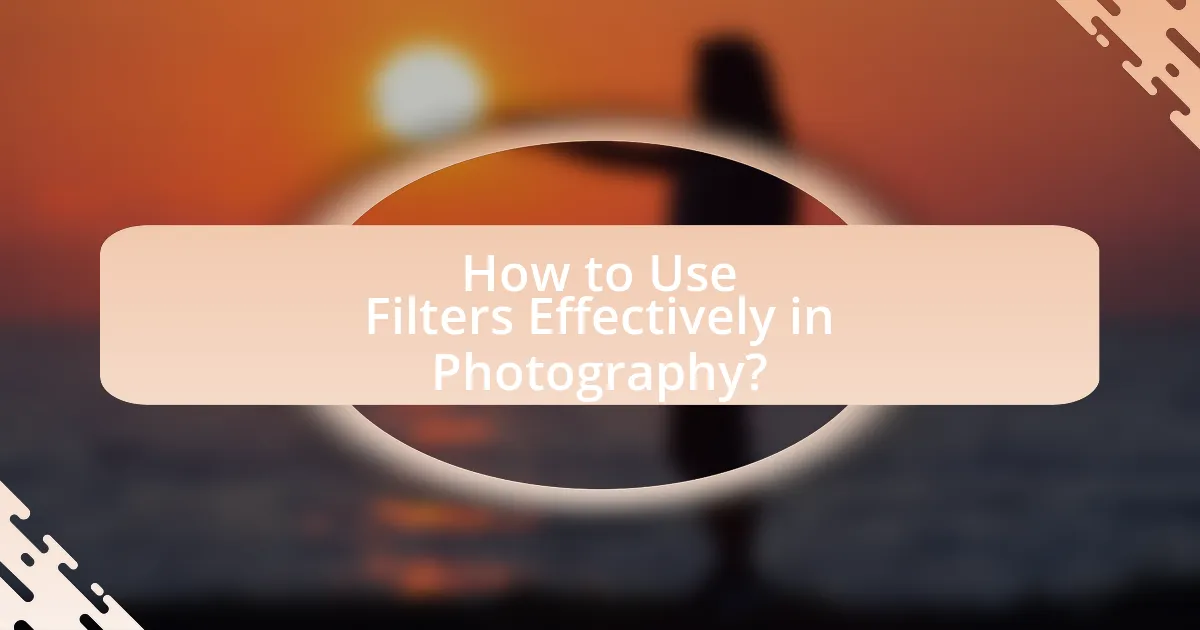Creative filters in photography are essential tools that modify images by altering colors, contrast, and textures, allowing photographers to achieve unique artistic effects. This article explores the various types of filters, including polarizing, neutral density, and color filters, detailing how they enhance image quality and influence mood. It also discusses techniques for effective filter use, common mistakes to avoid, and the impact of filters on black and white photography. By understanding and applying these filters creatively, photographers can significantly enhance their visual storytelling and artistic expression.

What are Creative Filters in Photography?
Creative filters in photography are specialized tools that modify the appearance of images by altering colors, contrast, and textures. These filters can create various effects, such as softening images, enhancing colors, or adding artistic elements like vignettes or textures. For instance, a polarizing filter reduces glare and enhances color saturation, while a graduated neutral density filter balances exposure in scenes with high contrast. The use of creative filters allows photographers to express their artistic vision and achieve unique results that may not be possible through post-processing alone.
How do filters enhance photographic images?
Filters enhance photographic images by modifying light before it reaches the camera sensor, resulting in improved color saturation, contrast, and overall image quality. For instance, polarizing filters reduce glare and reflections, allowing for clearer skies and more vibrant colors in landscapes. Neutral density filters enable longer exposure times without overexposing the image, which can create smooth water effects or motion blur in clouds. Additionally, color filters can alter the mood of an image by emphasizing specific hues, as seen in black and white photography where red filters can darken skies and enhance cloud contrast. These enhancements are widely recognized in photography, with studies showing that the use of filters can significantly impact the aesthetic appeal of images.
What types of filters are commonly used in photography?
Commonly used filters in photography include polarizing filters, neutral density filters, and UV filters. Polarizing filters reduce reflections and enhance colors, making skies bluer and foliage greener. Neutral density filters limit the amount of light entering the lens, allowing for longer exposure times without overexposing the image. UV filters protect the lens from dust and scratches while also reducing UV light, which can cause haziness in images. These filters are essential tools for photographers to manipulate light and improve image quality.
How do different filters affect light and color?
Different filters affect light and color by selectively allowing certain wavelengths to pass through while blocking others. For example, a polarizing filter reduces glare and enhances color saturation by filtering out polarized light, which can make skies appear bluer and foliage greener. Additionally, color filters, such as red or blue, can alter the overall hue of the image by absorbing specific wavelengths; a red filter will enhance reds and darken blues, while a blue filter will do the opposite. These effects are grounded in the principles of light absorption and transmission, which are fundamental to photography and optics.
Why should photographers use filters creatively?
Photographers should use filters creatively to enhance image quality and achieve unique visual effects. By employing filters such as polarizers, ND filters, or color filters, photographers can manipulate light, reduce glare, and control exposure, which leads to more dynamic and visually appealing images. For instance, polarizing filters can enhance color saturation and contrast in landscapes, while ND filters allow for longer exposure times, creating smooth water effects. These techniques not only improve technical aspects of photography but also enable artists to express their vision more effectively, as evidenced by the widespread use of filters in professional photography to achieve specific artistic outcomes.
What are the artistic benefits of using filters?
Using filters in photography enhances artistic expression by allowing photographers to manipulate light, color, and contrast. Filters can create specific moods or atmospheres, such as softening harsh light with a diffusion filter or enhancing colors with a polarizing filter. For instance, polarizing filters reduce glare and increase saturation, making skies appear bluer and foliage more vibrant, which can significantly impact the overall aesthetic of an image. Additionally, filters can help achieve effects that would be difficult or impossible to replicate in post-processing, such as long exposure effects with neutral density filters, allowing for creative interpretations of movement and time.
How can filters influence the mood of a photograph?
Filters can significantly influence the mood of a photograph by altering color tones, contrast, and overall ambiance. For instance, warm filters can evoke feelings of nostalgia and comfort, while cool filters may create a sense of calm or detachment. Research indicates that color psychology plays a crucial role in how viewers perceive images; for example, red tones can stimulate excitement, whereas blue tones often convey tranquility. By strategically applying filters, photographers can manipulate emotional responses, enhancing the narrative or theme of their work.

What are the Different Types of Creative Filters?
The different types of creative filters include polarizing filters, neutral density filters, color filters, and special effect filters. Polarizing filters reduce reflections and enhance color saturation, making skies bluer and foliage greener. Neutral density filters allow for longer exposure times without overexposing the image, enabling effects like motion blur in water. Color filters can alter the color balance of an image, often used in black and white photography to enhance contrast. Special effect filters, such as star filters or fog filters, create unique visual effects that can add artistic flair to photographs. Each type serves a specific purpose in enhancing the photographic experience by manipulating light and color.
What are the most popular types of filters for creative photography?
The most popular types of filters for creative photography include polarizing filters, neutral density filters, and graduated neutral density filters. Polarizing filters enhance colors and reduce reflections, making them ideal for landscape photography. Neutral density filters allow for longer exposure times without overexposing the image, which is useful for capturing motion in water or clouds. Graduated neutral density filters help balance exposure between the sky and land in high-contrast scenes. These filters are widely used by photographers to achieve specific artistic effects and improve image quality.
How do polarizing filters work and when should they be used?
Polarizing filters work by allowing only light waves that are oriented in a specific direction to pass through, effectively reducing glare and reflections from surfaces like water and glass. This is achieved through the filter’s polarizing layer, which can be rotated to control the amount of polarized light entering the camera. Photographers should use polarizing filters when capturing landscapes, particularly to enhance the contrast of the sky and reduce reflections from water, as studies show that they can increase color saturation and improve overall image clarity.
What effects can ND filters create in photography?
ND filters can create effects such as motion blur, reduced depth of field, and enhanced color saturation in photography. By limiting the amount of light entering the lens, ND filters allow photographers to use slower shutter speeds, which can result in smooth, flowing motion in subjects like water or clouds. Additionally, they enable wider apertures in bright conditions, producing a shallow depth of field that isolates subjects against a blurred background. This technique can also intensify colors by reducing glare and reflections, leading to more vibrant images.
How can color filters transform an image?
Color filters can transform an image by altering its color balance, contrast, and overall mood. For instance, a red filter can enhance the contrast in black-and-white photography, making skies appear darker and clouds more pronounced, while a blue filter can create a cooler tone, affecting the emotional impact of the image. Studies have shown that color perception significantly influences viewer emotions; for example, warm colors like red and orange can evoke feelings of warmth and excitement, while cool colors like blue and green can induce calmness. This manipulation of color not only enhances the aesthetic appeal but also conveys specific messages or themes within the photograph.
What are the effects of using warming and cooling filters?
Warming filters enhance the warmth of an image by adding yellow or red tones, resulting in a more inviting and cozy atmosphere, while cooling filters introduce blue or green tones, creating a cooler and more serene effect. These filters can significantly alter the mood of a photograph, influencing how viewers perceive the scene. For instance, warming filters are often used in portrait photography to create a flattering skin tone, while cooling filters are effective in landscape photography to evoke a sense of calmness or to simulate the look of twilight. The use of these filters can also affect color balance and contrast, making them essential tools for photographers aiming to achieve specific artistic effects.
How do color filters impact black and white photography?
Color filters significantly impact black and white photography by altering the tonal range and contrast of the final image. For instance, a red filter darkens blue skies and enhances cloud contrast, while a yellow filter can brighten skin tones and soften shadows. This manipulation occurs because filters absorb certain wavelengths of light, affecting how colors translate into shades of gray. The use of filters can lead to more dramatic and visually striking images, as evidenced by Ansel Adams’ use of yellow and red filters to enhance the depth and clarity in his black and white landscapes.

How to Use Filters Effectively in Photography?
To use filters effectively in photography, select the appropriate filter type based on the desired effect, such as polarizing filters to reduce glare and enhance colors or neutral density filters to control exposure in bright conditions. Understanding the specific function of each filter allows photographers to manipulate light and achieve creative results. For instance, polarizing filters can increase contrast in skies and reduce reflections on water, while ND filters enable longer exposures for capturing motion blur in waterfalls or clouds. This targeted application of filters enhances the overall quality and artistic expression in photographs.
What techniques can enhance the use of filters in photography?
Techniques that can enhance the use of filters in photography include understanding the specific purpose of each filter, such as polarizing filters for reducing glare and enhancing colors, and neutral density filters for controlling exposure. Additionally, using filters in combination can yield creative effects; for instance, stacking a polarizing filter with a graduated neutral density filter can balance exposure in high-contrast scenes. Proper positioning and angling of filters relative to the light source can also maximize their effectiveness, as seen in landscape photography where the angle can affect the saturation of colors. Furthermore, experimenting with different filter strengths and types allows photographers to discover unique visual styles, as evidenced by the varied results achieved in long-exposure photography using ND filters.
How can you combine multiple filters for creative effects?
You can combine multiple filters for creative effects by layering different types of filters, such as polarizing, neutral density, and color filters, to manipulate light and color in unique ways. For instance, using a polarizing filter can reduce glare and enhance colors, while a neutral density filter allows for longer exposure times without overexposing the image. This combination can create effects like smooth water surfaces or dramatic skies. Additionally, stacking color filters can alter the mood and tone of the photograph, enabling photographers to achieve specific artistic visions. The effectiveness of this technique is supported by the fact that many professional photographers utilize filter combinations to enhance their work, demonstrating its practical application in the field.
What are the best practices for using filters in different lighting conditions?
The best practices for using filters in different lighting conditions include selecting the appropriate filter type based on the specific lighting scenario. For bright daylight, using polarizing filters can reduce glare and enhance color saturation, while neutral density filters allow for longer exposure times without overexposing the image. In low-light conditions, using a graduated neutral density filter can help balance exposure between the sky and foreground. Additionally, using warming filters during golden hour can enhance the warm tones of the light. These practices are supported by the fact that filters can significantly impact image quality and exposure control, as demonstrated in various photography guides and studies.
What common mistakes should photographers avoid when using filters?
Photographers should avoid overusing filters, as excessive application can lead to unnatural images and loss of detail. Filters, such as polarizers or ND filters, should be used judiciously to enhance specific aspects of a scene without compromising the overall quality. Additionally, photographers often neglect to check for vignetting or color casts introduced by filters, which can detract from the final image. It is also crucial to ensure that filters are clean, as dirt or smudges can result in unwanted artifacts. Lastly, photographers should be aware of the filter’s effect on exposure settings; failing to adjust shutter speed or aperture accordingly can lead to improperly exposed images.
How can improper filter use affect image quality?
Improper filter use can significantly degrade image quality by introducing unwanted artifacts, altering color balance, and reducing sharpness. For instance, using a polarizing filter incorrectly can lead to uneven lighting and color saturation, resulting in unnatural images. Additionally, stacking multiple filters can cause vignetting and loss of detail, particularly in the corners of the frame. Studies have shown that filters can introduce optical distortions, which can compromise the overall clarity and fidelity of the photograph.
What are the signs of over-filtering in photography?
The signs of over-filtering in photography include unnatural color shifts, loss of detail, and excessive contrast. Unnatural color shifts occur when filters alter hues beyond realistic representation, leading to images that appear overly saturated or unrealistic. Loss of detail is evident when fine textures and sharpness diminish, often resulting from heavy use of softening or diffusion filters. Excessive contrast manifests as overly dark shadows and blown-out highlights, which can detract from the overall image quality. These indicators collectively suggest that the application of filters has been excessive, compromising the integrity of the photograph.
What tips can help photographers maximize their filter usage?
Photographers can maximize their filter usage by understanding the specific effects each filter provides and applying them strategically in various shooting conditions. For instance, polarizing filters reduce glare and enhance color saturation, making them ideal for landscape photography, especially when capturing skies and water. Neutral density filters allow for longer exposure times, enabling creative effects like smooth water or motion blur in clouds, which is particularly useful in bright conditions. Additionally, using graduated neutral density filters can help balance exposure between the sky and foreground in high-contrast scenes. Understanding the characteristics of each filter and practicing their application in different scenarios can significantly enhance a photographer’s creative output.